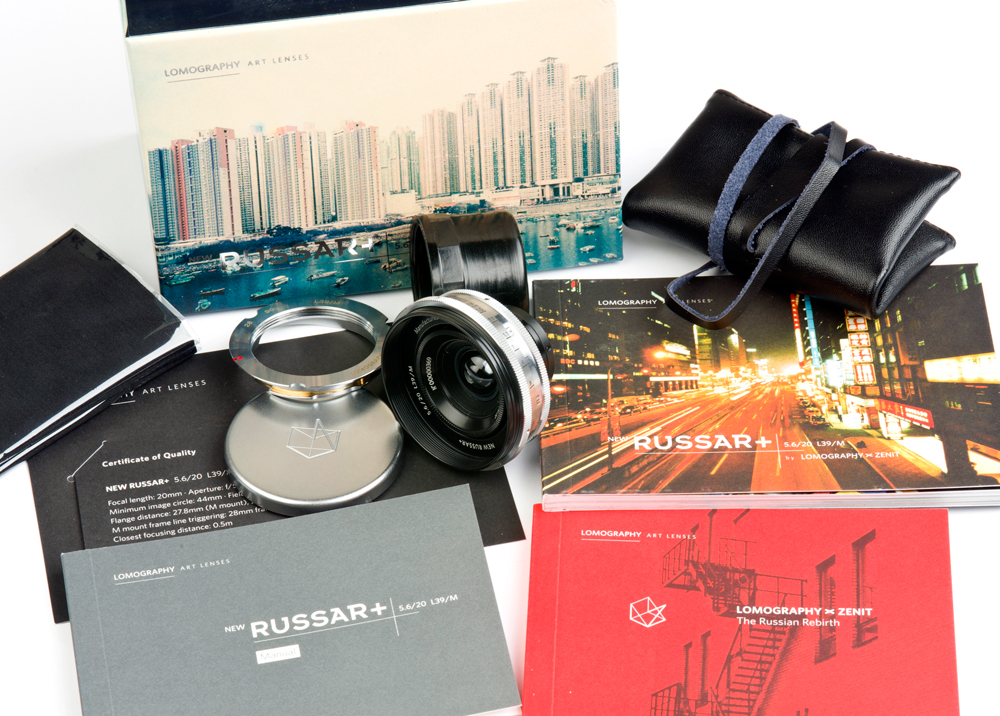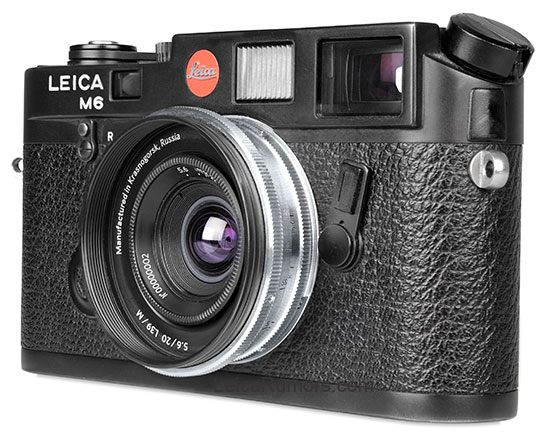
I was very surprised opening up the newest Lomography remake - the Russar 20mm f/5.6 Leica Screw mount lens. I was expecting the kind of dull workmanship of the original. Instead I found a wonderfully boxed lens which appears to have outstanding craftsmanship. Those crafty Lomography people are certainly working had to get Leica owner's rubles ... make that dollars for the US.
This is a very nicely done lens. Something to make your Leica sit up on its Hermes cushion and take notice.
Never heard of the Russar? Well once upon a time in 1958 the crafty Ruskies won the Grand Prize at the Brussels World's fair with the original MR Russar 20mm f/5.6 lens design. Small and compact, it was pretty hot for a 1958 super wide angle Leica screw mount lens. You can read its interesting story here on the Lomography site. This is a brand new updated and improved 2015 version.
The Russar was, and is, a scale focused super wide (not rangefinder coupled) in Leica Screw Mount. It is happily factory provided with an official screw mount to M adapter. You will find some nice sample images here.
And so the MR Russar was originally designed for any Leica Screw Mount camera or M mount camera by adding the M adapter.
With the wonders of the so called mirrorless cameras it is also easily adaptable to the Sony Alpha 7 series, FujiX series, and M43 Panasonic a Olympus camera via the appropriate adapter.
$649 with free shipping. Chrome only.
More pics and ordering here
Corran
Well-known
I'm curious what the draw is, considering the Voigtlander Skopar is about 2/3 the price, 1-stop faster, and actually RF coupled?
It certainly looks cool and would pair well with an LTM camera, but that's pretty steep for what it is, IMO.
It certainly looks cool and would pair well with an LTM camera, but that's pretty steep for what it is, IMO.
I'm curious what the draw is, considering the Voigtlander Skopar is about 2/3 the price, 1-stop faster, and actually RF coupled?
It certainly looks cool and would pair well with an LTM camera, but that's pretty steep for what it is, IMO.
take a look at the pics on the Lomo site
The Voigtlander 21/4 has a sharp modern look,
the Russar a vintage wide angle look
the choice depends upon the type of image you are after
Huss
Veteran
Very cool. It would have been nice if they made the Minitar 32mm lens in LTM mount (still RF coupled) like this Russar.
I dig it. But I already have an 18mm lens, and a 21mm..
I dig it. But I already have an 18mm lens, and a 21mm..
Corran
Well-known
take a look at the pics on the Lomo site
The Voigtlander 21/4 has a sharp modern look,
the Russar a vintage wide angle look
the choice depends upon the type of image you are after
Lomo's sample images always leave me wondering what they were after, but that's just me perhaps. Anyway, more power to them for making a new product, I just think their price-point is way off-base.
Travis L.
Registered Userino
This is at the top of my Christmas list
raid
Dad Photographer
Is this lens safe for digital cameras? My vintage Canon 19mm and Rokkor 21mm lenses hit the sensor
f16sunshine
Moderator
It's a modern build Zeiss topogon scheme for 135 format.
Beautiful sharpness and contrast with a bit of vignetting at wide open.
Had an original one for a couple years.
The build on this new model looks beautiful!.
Can't wait to try one with some tri-x !
Like this zeiss but wider.
http://www.mir.com.my/rb/photograph...F-Nikkor/Contax_RF/ContaxZeissTopogon25mm.htm
Beautiful sharpness and contrast with a bit of vignetting at wide open.
Had an original one for a couple years.
The build on this new model looks beautiful!.
Can't wait to try one with some tri-x !
Like this zeiss but wider.
http://www.mir.com.my/rb/photograph...F-Nikkor/Contax_RF/ContaxZeissTopogon25mm.htm
nhchen
Nathan
It's a modern build Zeiss topogon scheme for 135 format.
Beautiful sharpness and contrast with a bit of vignetting at wide open.
Had an original one for a couple years.
The build on this new model looks beautiful!.
Can't wait to try one with some tri-x !
Like this zeiss but wider.
http://www.mir.com.my/rb/photograph...F-Nikkor/Contax_RF/ContaxZeissTopogon25mm.htm
i always thought it was an original russian design. The orion-15 lens was based on the original topogon.
http://www.marcocavina.com/articoli_fotografici/Soviet_and_wide_lenses_on_Leica_M/00_p.htm
nathan
Alberti
Well-known
Lomo's sample images always leave me wondering what they were after, but that's just me perhaps. Anyway, more power to them for making a new product, I just think their price-point is way off-base.
It looks like they want to live up to the 'Lomography' look in the PR: many bleached out low res film images.
They probably don't have digital bodies yet.
I'm interested in the difference between single (Russar MR-2. , for the MM) and multicoated (New Russar for color).
Filzkoeter
stray animal
i always thought it was an original russian design. The orion-15 lens was based on the original topogon.
http://www.marcocavina.com/articoli_fotografici/Soviet_and_wide_lenses_on_Leica_M/00_p.htm
nathan
It is an original russian design... funny fact: the original Russar is the design the Aviogon/Biogon/Super-Angulon lenses were based on
This makes the Russar the grandfather of all symmetrical ultra-wide-angle lenses
squirrel$$$bandit
Veteran
That is a very cool looking lens. Any photos of it on an M?
edit: yes!

edit: yes!

f16sunshine
Moderator
Alberti
Well-known

[Original] Russar on MM
On M it gives - as expected - great purple fringes on the sides.
- Is there any lens code setting to overcome that?
nukecoke
⚛Yashica
Indeed.
The FED 28mm f/4.5 seems to be the only russian original lens in LTM. I might be wrong but I haven't seen an older scheme that the 28/4.5 was possibly based on.
Alberti
Well-known
Marco Cavina, an Italian lens expert, described the Russar as an original Russian design; the schema developed from a reconnaissance lens for large format.
I can read some Italian, and his history of the lens is convincing. A first 100 mm version was developed in 1942; a patent was filed in the USA immediately after the war. In 1956 a LTM version was developed, first an experimental model for LenZOS factory, then a renewed calculation emerged for the LZOS factory. [I have that version with a number in the 31nn range]
Cavina praises the lens for its naturalness. The vignetting follows a different form factor from other lenses. Objects retain their character until the edges.
In practice, he says it exhibits more light fall-off than claimed.
My own observation is that the Russar has better corners than the Elmarit-M. And indeed I like the naturalness that is very well expressed on the MM. Distance objects can be soft.
The distance of the last lens to the sensor plane is 11 mm. Still, the light meter functions very well on my digital body.
Even uncoded the light fall-off is well controlled and gives a natural 'pop'.
I can read some Italian, and his history of the lens is convincing. A first 100 mm version was developed in 1942; a patent was filed in the USA immediately after the war. In 1956 a LTM version was developed, first an experimental model for LenZOS factory, then a renewed calculation emerged for the LZOS factory. [I have that version with a number in the 31nn range]
Cavina praises the lens for its naturalness. The vignetting follows a different form factor from other lenses. Objects retain their character until the edges.
In practice, he says it exhibits more light fall-off than claimed.
My own observation is that the Russar has better corners than the Elmarit-M. And indeed I like the naturalness that is very well expressed on the MM. Distance objects can be soft.
The distance of the last lens to the sensor plane is 11 mm. Still, the light meter functions very well on my digital body.
Even uncoded the light fall-off is well controlled and gives a natural 'pop'.
That is a very cool looking lens. Any photos of it on an M?
edit: yes!

Drool....
das
Well-known
I know that the depth of field is large with a 20mm, etc., etc. But do you think there is there a way to modify one of these lenses for rangefinder coupling? Could an experienced modifier accomplish this?
Ko.Fe.
Lenses 35/21 Gears 46/20
I know that the depth of field is large with a 20mm, etc., etc. But do you think there is there a way to modify one of these lenses for rangefinder coupling? Could an experienced modifier accomplish this?
For sure. They will charge you the price to make it equal to 21 SEM.
Godfrey
somewhat colored
I know that the depth of field is large with a 20mm, etc., etc. But do you think there is there a way to modify one of these lenses for rangefinder coupling? Could an experienced modifier accomplish this?
For sure. They will charge you the price to make it equal to 21 SEM.
LOL!
You really don't need RF coupling for a 20mm f/5.6 lens. Wide open on a 35mm film or FF camera, the hyperfocal distance is 7.5 feet, which nets 4.25 feet to infinity in acceptable sharpness. Stop down to f/8 and you get 3.5 feet to infinity @ 6.5 foot distance. Stop down to f/11 and you get 2.8 feet to infinity @ just under 4 foot focus distance.
If it were an f/2 lens, yeah RF coupling would be nice for close in work. But not with an f/5.6 lens: Just set a reasonable distance on the scale and you're good.
G
Share:
-
This site uses cookies to help personalise content, tailor your experience and to keep you logged in if you register.
By continuing to use this site, you are consenting to our use of cookies.
